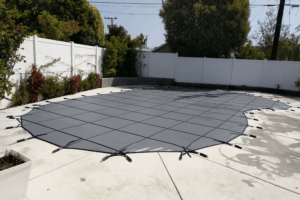
Pool Area Maintenance Tasks You Shouldn’t Skip
Even diligent pool owners miss key maintenance steps. Use this checklist to catch commonly forgotten tasks and keep your pool area safer and more efficient year-round.

Safely opening a pool after winter takes some work, but it also moves you one step closer to warm summer days relaxing poolside, getting in your laps, or splashing around with the family. Winterizing your pool through the colder months helps protect it from damage related to low temperatures and inclement weather while it’s not getting the regular use and inspection that can spot an issue before it becomes a problem. Opening your pool back up safely also protects your pool while ensuring it’s ready for safe, protected summer fun that can help prevent accidental drowning injuries, still one of the top killers in America.
Opening a pool takes more than just a garden hose because you’re not just getting your pool ready for swimming. You’re preparing it to be a safer swimming area, where your family, friends, and pets are protected from illness and injury. Opening a pool after winter means knowing how to clean the pool, reinstalling the necessary pool equipment and accessories, and making sure the area is both safe to be in and safer from unsupervised access. By methodically following a safe opening procedure, you can be ready for fun without compromising on safety.
By the time winter ends, your winter swimming pool safety cover has been through a lot. Dropping temperatures, ice, snow, freezing rain, high winds, and more have all done their best to tackle it, but the cover is going strong. Proper pool opening makes sure it’s stowed away, ready to return at the end of the year, without leaving your pool open to unsupervised access by children, pets, or wild animals that may be used to the additional surface that will support their weight.
After a few times, opening your pool after winter will be a fun way to mark the changing of the seasons and get ready for the lazy days ahead. We’re ready to help you protect your pool with customized safety solutions from your local All-Safe Pool installer. They’ll talk to you about your safety concerns, take some measurements, and tailor a free, no-obligation quote to your pool and activities so you can see how affordable peace of mind can be. Get the information you need for an informed decision about your pool’s safety with a no-cost estimate from your All-Safe Pool pro today.

Even diligent pool owners miss key maintenance steps. Use this checklist to catch commonly forgotten tasks and keep your pool area safer and more efficient year-round.

Learn the most common pool winterizing mistakes and how to avoid them for a safer, cleaner backyard during the off-season.

Mesh pool covers offer reliable winter protection by keeping out debris and preventing accidents. Learn why they’re a smart choice for safety and peace of mind.
Enter your zip code to locate an independent installer in your area
Enter your zip code to locate an independent installer in your area

Due to the many variations in monitors, phones, and browsers, color samples and product examples may appear different on different screens. Computers and mobile devices are not all calibrated equally and color reproduction on the Internet is not precise. The same is true for printed items such as brochures and other sales literature.
In addition, the colors of our products photograph differently under different lighting conditions. For example, photos taken in full sunlight will vary from photos taken on a cloudy or overcast day. Similarly, shadows from nearby objects can affect the color and transparency of our products. If a precise color or specific shade is important, please inspect the actual color of your product prior to installation.
Many of our products’ materials are not available through typical stores and vendors and therefore must be custom manufactured specifically for our use. In order to control costs and provide you with the best value possible, our raw materials are produced in large batches and can often take several months to receive. The colors of our materials can, and often do, vary slightly from batch to batch. Although we make every effort to minimize color variations, we cannot be responsible for these differences when they occur. If a precise color or specific shade is important, please inspect the actual color of your product prior to installation.
For example, we use the name “putty” to describe some of our products. Your idea of the color “putty” may be different than someone else’s idea of “putty”. In addition, products may have the same color name but may not be the exact same color. For example, we have different shades of “black”. Please do not order using color names as your only guide. If a precise color or specific shade is important, please inspect the actual color of your product prior to installation.
If it is important that your product be an exact color or shade, it is highly recommended that you inspect the actual product prior to its installation and address any concerns with your local independent installer. Most independent installers do not offer refunds or accept returns due to color variations.